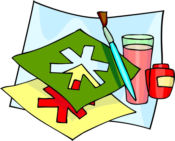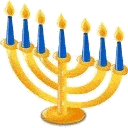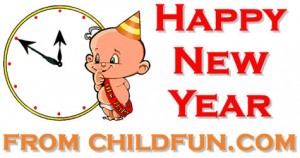Chinese New Year is the most important of the Chinese holidays, and is a time of feasting with the family, celebration, fireworks, and gift-giving. It is a 15-day holiday, beginning on the first day of a new moon and ending with the full moon on the day of the Lantern Festival.
The Chinese calendar is based on the lunar year, so the date of Chinese New Year changes every year. It follows a 12-year pattern with each year named after an animal. There are various stories which explain this. The simplest is that Buddha (or the Jade Emperor) invited all of the animals to join him for a New Year celebration, but only 12 animals turned up.
To reward the animals that did come, Buddha named a year after each of them in the order that they arrived, starting with the Rat, followed by the Ox, Tiger, Rabbit, Dragon, Snake, Horse, Goat (or Sheep), Monkey, Rooster, Dog and Pig. (Find another version of the story to print, below) Depending on the year you are born, you are believed to have the various character traits of that year’s animal.
January can seem awfully long sometimes!
Listed below are some activities that parents and their children might like
to do together while they’re waiting for the Chinese New Year to arrive.
Have fun!
Chinese New Year Arts and Crafts
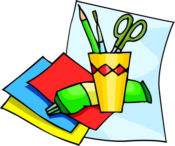
CREATE CHINESE CHARACTERS
Rice or Sand in a Pan:
The child can use the stick to practice creating a Chinese symbol in the pan
of rice or sand.
Tracer Sheet: (a piece of paper with an Chinese character enlarged on it)
On a red paper, a child could trace the lines of a Chinese character with
glue and put scrunched squares of yellow tissue paper or pieces of gold
glitter on the glue to create a poster or banner.
Using a laminated tracer sheet, the child can follow the lines of the
Chinese character to place play dough, baking soda dough or modeling clay in
the proper location to create the character. The baking soda dough and
modeling clay can be dried and painted.
Older children can use the tracer sheet to create the character from strips
of rolled fabric or yarn that have been pinned into place and then treated
with a fabric stiffening product.
Paint and Calligraphy
Using a reference sheet, calligraphy (or a child’s paintbrush and non-toxic
paint) could be used to create the characters. By using red gift wrap paper
and attaching cardboard tubes at the ends so the calligraphy message could
be rolled, the ambitious child could create a calligraphy message on a
scroll.
FIRECRACKERS
On a sheet of construction paper (black is most effective), place a small
amount of brightly coloured non-toxic paint. Have the child use a straw to
blow the paint in all directions to create the effect of a firecracker
exploding. Repeat this instruction several times using different coloured
paints.
If desired, a Chinese New Year parade could be created at the
bottom of the paper so it appears that the fireworks are in the night sky.
Older children could do a similar activity but in the form of a diorama.
MASKS
The faces of the Chinese lion and dragon can be created as masks. The mask
can be as simple as a paper plate being decorated with crayons, markers,
strips of tissue paper, paint and construction paper. The more elaborate
mask can be made with paper mache. The animals in the Chinese Zodiac could
also be created into masks.
MOBILES AND CARDBOARD SCULPTURES
Egg cartons, tissue boxes, cardboard rolls, small gift boxes, paper cups,
and various sized cardboard boxes can be creatively assembled to resemble a
Chinese lion, dragon or any of the Chinese Zodiac animals. Add lots of
bright colored paint and strips of tissue paper to make the sculpture or
mobile appear real! It’s a great project for a small group of children who
want to work together.
LANTERNS
Construction Paper Lanterns:
Two sheets of red construction paper are required to create the lantern.
The height of the first sheet of construction paper will remain intact but
the second paper must be trimmed so it is two-thirds the height of the first
sheet (ie. cut off one third of the height).
Using the first (taller) sheet, the exterior of the lantern will be created
by cutting (approximately) six parallel slits, evenly spaced, in one sheet
of red construction paper. Create a tube by attaching, with glue, the ends
that are parallel to the slits.
Make a tube with the second paper by attaching the sides together. Ensure
that the second paper tube will fit inside the first tube.
Slide the second tube into the middle of the first tube and join and glue
the tops and bottoms of the tubes. The slits in the exterior of the lantern
will “puff out” to give the lantern shape. Add a handle and it is ready to
be decorated. (Another strategy is to decorate the first sheet of paper
prior to cutting the slits.)
Decorate the lantern with gold (and black) using markers, paint, and yarn.
Chinese characters can be painted on or ‘cut and pasted’ from restaurant
advertisements.
Ready Made Lanterns
White paper lanterns can be purchased at some craft stores or at a large
Swedish furniture store and decorated with tissue paper.
LAI SEE
If a pattern is needed, take apart a purchased red envelope and create a
tracer for the children. The envelope shape can be traced, assembled and
decorated. Using gold markers and glitter and glue are effective ways to
decorate the envelope. Circular foil-covered chocolates can be placed in
the envelope instead of money and the children can give the lai see to their
friends.
CARDS
Chinese New Year cards are available in stationary stores but the children
can make their own cards in a manner similar to the red envelopes. School
aged children could create “pop-up” cards by utilizing the instructions from
art books but modifying them to match the theme.
If internet access is available, most electronic postcard sites stock
Chinese New Year cards.
Chinese New Year Games and Activities
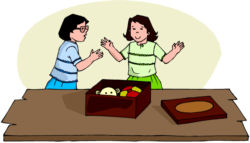
BOOKS
A Chinese New Year themed storybook or comic book could be created. One of
the Chinese legends or folk tales could be retold in the child’s own words
and illustrated. Since most dragons in Chinese legends are good, the child
could consider creating a book based on the adventures of a good dragon.
HOROSCOPES
If internet access is available, one can conduct a search for Chinese New
Year horoscopes. (The Hong Kong Travel Association site usually has
horoscope listings beginning one week prior to the Chinese New Year.)
CHOPSTICKS
Make chopsticks with “training wheels” for the children to experiment with. (Most Chinese restaurants will gladly give you several pairs free!) Using the paper wrapper each pair comes in, accordian fold the paper (front, back, front, back ETC) into a small rectangle Secure the rectangle between the two sticks with a small rubber band. This “separator” is just enough to allow kids to pick things up using a pincer grasp. You can set out small items to be picked up and put in to a devided tray for sorting or even a clean egg carton with the lid cut off, these work great and are easily available.
CHOPSTICK PAINTING: Cut long strips of easel paper (maybe 4 to 6 inches wide and just the length of the paper, is fine) Clip them to the easel and let the kids paint with chopsticks and black paint. It helps re-enforce the concept if you have examples of Asian writing displayed.
FISH PRINTS: You can buy a real fish or purchase a plastic fish tray. (I got ours at the dollar store.) Using a paint brush and any color tempera you like, let the kids paint one entire side of the fish or the bottom side of the tray. Lay a piece of white paper on the painted side and rub all over the paper, concentrating on the eyes and the edges for a complete outline. We have used blue or red paint and white paper. When they are dry, we like to cut them out and hang them from our ceiling to decorate our classroom. These are very popular!!
RICE: We Like to have rice in our sensory table. You can shake rice in a lg. ziplock with liquid watercolor or food coloring and vinegar to create colored rice to collage with. And of course, make steamed rice to sample.
Other ideas: Make kites or lanterns out of construction paper, have a Chinese New Year Dragon parade, Read The Paper Crane and learn to fold paper cranes. Call your local Asain American Club or Neighborhood Senior center and ask if they can pass your name along to a willing Senior Citizen who may want to come in and share their culture or read stories during the week. (If you don’t have a willing parent/grand parent.) We had a Mom come in and make name tags for the kids showing their name in english and Chinese and bring in some cookies/snacks to sample!
kids
Clay Slab Dish
(dough)
1 cup salt
2 cups flour
4 teaspoons Cream of Tartar
2 cups COLD water
Mix all ingredients in your cooling pot. Stir in the cold water, mixing with your hands or a spoon. Cook on medium heat, stirring constantly until the dough looks like mashed potatoes or a firm ball. This dough an be molded and will air dry in 12 to 36 hrs.
Clay Slab Dish
Equipment:
Rolling pin,
A ruler, dinner knife, glue, paint brush
Black and White paint
Practice Paper
Make a batch of salt clay and, let cool. (depending on how many children are doing the craft. Each child needs a ball of dough the size of a grapefruit). Roll a piece the size of a grapefruit out to 1/4 in. thickness.
Using ruler as a guide, measure and cut out a rectangle 4×51/2 in. They can roll 4 little balls (dish feet) to be attached later.
Place rectangle on a non-stick surface and curl up each corner. Support the upturned corners with paper wads until clay is dry. The salt clay dries sloooowly! Placing the dish and feet in a slightly heated oven overnight will speed drying process. When dish is dry, attach feet with glue. Paint the slab dish a color, (they are usually white but, they can make them any color they choose). Let dry.
Let the children take a piece of pratice paper, and practice their designs with pencil. When they are happy with a design, they can then paint it on their Slab Dish. If anyone has pictures of calligrafied messages, or knows how to do calligraphy, this idea would make the dish more authentic.
More ideas for rolled clay (slab dishes) Fish Plate, Leaf Plate, Plate with a shallow rim. All are traditionally Asian. Commercial self-hardening clay works well also.
Painted flower designs each have a special meaning.
Peonies-Spring
Flowering Plums-Winter
The Lotus (Sacred flower of Buddha)-Summer
Chrysanthemum-Fall.
Another Asian Craft Idea. (this one would probably be difficult for children under 8 years of age).
Paper Chains
Equipment: Large brightly colored paper you can use (construction paper, butcher paper, wallpaper, wrapping paper).
Scissors, pencil, sponge, or rag, paint (water based), tray for paint, glue/tape.
Cut paper into strips 5-7 inches wide, and as long as possible. Fold accordion-style into 3 or 4 sections. Cut off excess paper. Choose a pattern (if you have any) Trace pattern or, design your own. Ensure that some part of design extends at least to the folded sides so that when cut, shapes are connected. You can paint with a sponge, and let dry.
Once it’s dry, Fold strip again, and cut out design. To keep hayers from slipping, staple/paper clip layers together on the part that is to be cut off. Repeat until you have several strips. Fasten together the parts of your paper chain using glue/tape (at the tail, front feet, etc.)
Tips:
Good papers to use: origami-printed papers, decorative gift wrap, wallpaper, and constrution paper.
Construction paper may be too bulky to cut when folded more than 2 thicknesses.
Adult can help cut small areas with a utility knife.
SPONGE PAINTING
Shallow tray with paint. Touch sponge into paint and lightly daub laid out paper. Let dry before folding. Try more than one color of paint.
Chinese New Year Recipes and Snacks
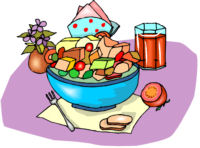
FOOD
Cooking with a toddler can be an experience but think of it as a humourous
anecdote to share at a later date!
Butterfly shaped cookies can be made by having the child twist opposite
corners of a wonton wrapper to resemble a butterfly. An adult can fry them
in oil and, while they are cooling, the child can sprinkle sugar on them.
snackOne time, on a listserv, there was an idea from a teacher who had young
students fill wonton wrappers with cut up peaches and brown sugar. The
children wet and pressed the edges of the wrapper together. The teacher
fried the wontons in a wok and the children loved them.
Of course, there’s always the chicken and vegetable stirfry!
CHOPSTICKS
The picture book, Cleversticks, (ISBN 0-00-663855-4) can be read and
everyone can practise using chopsticks to eat noodles.


